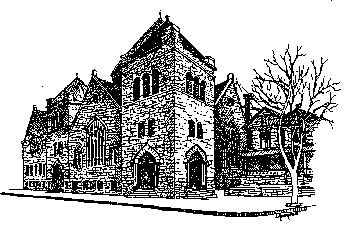The Evangelical Church and the United Brethren in Christ were both German-speaking bodies influenced by Methodism and Pietism. Each was founded at the turn of the nineteenth century, and had talked of union as early as 1813. It was not until 1924 that conversation began to move towards action and union discussions began in earnest.
Formal merger came in November 1946. For three days, the two denominations held their last General Conferences in separate sessions in Johnstown, Pennsylvania. The Evangelical Church met at Beulah Dale Evangelical Church and the United Brethren in Christ met at the First United Brethren Church.
On Saturday, November 16, 1946, at 9:00 a.m., delegates and visitors from both denominations filled the sanctuary of the First United Brethren Church. As Evangelical and United Brethren bishops processed to the chancel, the congregation sang “Lead On, O King Eternal.” Bishop A. R. Clippinger read the formal declaration of union, which was followed by the singing of “Blest Be the Tie That Binds.” The new church then celebrated Holy Communion and entered into the business sessions of the first General Conference of the newly organized Evangelical United Brethren Church.
In his episcopal address, Bishop A. R. Clippinger expressed the hopes of the new denomination:
“We believe that this is the will of our Heavenly Father, and that it will be his good pleasure to bless our efforts. In that spirit we launch this new Ship of Zion on uncharted seas and choose to call it The Evangelical United Brethren Church. The same North Star that guided us safely, as separate denominations, through rough and turbulent waters, will guide this new Ship of Zion to its desired haven.”
Membership of the new denomination was over 750,000. In 1968, The Evangelical United Brethren Church merged with The Methodist Church to form The United Methodist Church.
The Johnstown church building was dedicated on November 24, 1912. Initially called First United Brethren Church, it is today named First United Methodist Church of Johnstown.
Points of interest at this Heritage Landmark: The church maintains a history room which displays items from the church’s history as well as from the 1946 uniting conference.
Special events: The church celebrates an Anniversary Sunday on the second Sunday of November each year.
Area attractions: The Johnstown Flood Museum at 304 Washington Street displays memorabilia documenting the development of Johnstown as a transportation and industrial center as well as the famous 1889 flood.
The city of Pittsburgh is west of Johnstown.
To visit: The First United Methodist Church is an active United Methodist congregation. It is open for regular worship; contact the church if you wish to visit at another time: 436 Vine Street, Johnstown, PA 15901; 814-536-8844. The church is open Monday through Thursday, 9:00 a.m. to 12:00 p.m. and 12:30 p.m. to 4:00 p.m. Friday’s hours are 9:00 a.m. to 12:00 p.m., Saturdays by appointment, and Sundays 9:00 a.m. – 12:00 p.m.
Location: Within the boundaries of the Western Pennsylvania Annual Conference in Cambria County, Pennsylvania. The church is on Vine Street in downtown Johnstown.
Food and lodging: There is a Holiday Inn at 250 Market Street; 814-535-7777.
Directions: From Interstate 76 (the Pennsylvania Turnpike), take the Somerset exit (route 219 north). Exit route 219 at the Johnstown Expressway, route 56 west. Take the Bedford Street exit. Go straight through three lights, then left on Vine Street. Go through one light. The church is on the left.
For further information, contact: Dennis L. Zimmerman, Pastor, First United Methodist Church, 436 Vine Street, Johnstown, PA 15901; 814-536-8844.
To learn more about United Methodist church history in this area:
Western Pennsylvania Annual Conference Archives, Pelletier Library, Allegheny College, Meadville, PA 16335; J. Howard Smith, Archivist; 814-724-3768.
J. Bruce Behney and Paul H. Eller, The History of the Evangelical United Brethren Church (Nashville: Abingdon Press, 1979).
Arthur C. Core, Evangelical United Brethren Reader: A Documentary Source Book (Dayton, OH: United Theological Seminary, 1963).

